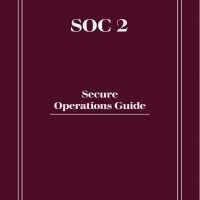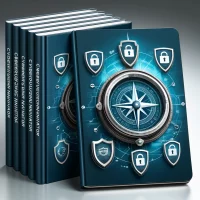“Leadership in Cybersecurity” is a seminal work that addresses the increasingly crucial intersection of leadership prowess and cybersecurity expertise. This book is designed not only for current leaders in the field but also for those aspiring to such roles, providing a comprehensive guide to navigating the complexities and challenges of leading in a digitally precarious environment.
At its core, the book emphasizes the unique requirements of leadership in the cyber domain—where rapid technological change and persistent threats necessitate a blend of strategic foresight, ethical compass, and technical knowledge. The author successfully demystifies these complexities, offering insightful strategies that merge leadership principles with effective cybersecurity frameworks.
Through a series of practical strategies and real-world case studies, “Leadership in Cybersecurity” showcases how to integrate cybersecurity into a broader leadership ethos effectively. It pushes the reader to recognize cybersecurity not just as a technical hurdle but as a strategic component crucial for innovation and trust in digital transformations. This perspective shift is what sets the book apart—it reframes cybersecurity as a foundational element of modern leadership rather than a peripheral concern.
Furthermore, the book tackles the often-overlooked human element of cybersecurity, emphasizing the role of leaders in fostering a security-conscious culture within their organizations. By advocating for proactive and intelligence-driven leadership approaches, it provides a blueprint for crafting and implementing comprehensive cybersecurity measures that anticipate and mitigate potential digital threats.
“Leadership in Cybersecurity” is an invaluable resource for anyone involved in the strategic layers of organizations, from C-suite executives to IT managers. It bridges the gap between abstract security concepts and actionable leadership decisions, making it a must-read for leaders determined to forge resilient, forward-thinking organizations in an era where cyber threats are part of the business landscape.
An Interview with the Author
Thanks for joining us. Your book tackles the intricate relationship between leadership and cybersecurity. Could you tell us about the pivotal moment that led you to focus on this specific intersection?
Author: It’s great to be here, thank you. The pivotal moment came from observing recurring gaps in how organizations responded to cybersecurity incidents. I noticed that the most successful responses were not just technically adept but also strategically sound, with clear communication and leadership. It became apparent that cybersecurity challenges were as much about leadership and strategy as they were about technology.
In “Leadership in Cybersecurity,” you argue for a proactive approach to managing digital risks. What are some innovative strategies leaders can adopt to anticipate and mitigate these risks?
Author: One innovative strategy is to implement scenario-based planning, which involves creating detailed scenarios of potential cybersecurity threats and working through them systematically to develop response strategies. This not only prepares the organization for specific incidents but also helps in developing a general strategic thinking ability among leaders regarding cybersecurity. Another strategy is to leverage artificial intelligence and machine learning to predict and identify potential vulnerabilities before they are exploited.
Your book emphasizes the need for a security-conscious organizational culture. What are common obstacles leaders face in fostering this environment, and how can they overcome them?
Author: A common obstacle is resistance to change, especially from employees who might not understand the direct impact of cybersecurity on their daily work. Leaders can overcome this by integrating cybersecurity awareness into the core values of the company culture. This might include regular, engaging training sessions, clear communication about the real-world impact of security breaches, and transparent policies that everyone can follow easily.
Cybersecurity is a fast-evolving field. What resources or habits should leaders cultivate to keep their knowledge and skills current?
Author: Leaders should cultivate the habit of continuous learning, which can be supported by subscribing to leading cybersecurity publications, attending relevant conferences, and participating in industry workshops. Building a network with other cybersecurity leaders can also provide valuable exchanges of ideas and updates about new threats and innovations in the field.
After reading “Leadership in Cybersecurity,” what immediate actions should leaders take to start improving their cybersecurity stance?
Author: A great first step is to conduct a comprehensive cybersecurity audit to assess the current security posture. Following the audit, leaders should prioritize the identified vulnerabilities based on their potential impact and the feasibility of mitigation strategies. It’s also critical to engage all levels of the organization in cybersecurity training and drills to ensure that every employee can act as a first line of defense against cyber threats.
“Leadership in Cybersecurity” Now Available in Multiple Languages
We are excited to announce that “Leadership in Cybersecurity” is now accessible in a variety of languages, reaching a global audience. Whether you are fluent in Catalan, Spanish, Danish, German, Finnish, French, Hindi, Italian, Portuguese, or Swedish, you can now explore this essential guide in your native language. This expansion aims to empower leaders around the world with the tools and knowledge needed to enhance their cybersecurity strategies effectively, ensuring a broader impact on improving digital security practices across diverse business landscapes.
Discover the “Cybersecurity Leadership Mastery” Series
“Leadership in Cybersecurity” is an integral part of the acclaimed book series titled “Cybersecurity Leadership Mastery,” alongside “The Art of Cyber Defense,” “Incident Response Leadership,” and “CISO Essentials.” This series is crafted to provide a comprehensive understanding and strategic insights into the various facets of cybersecurity leadership. Each book is designed to equip current and aspiring leaders with the necessary knowledge and tools to navigate and excel in the complex world of cybersecurity management. By exploring different angles and aspects of cybersecurity, the series offers a well-rounded approach to developing the skills needed to lead and protect in today’s digital landscape.



















